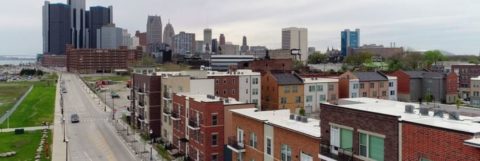Crain’s Detroit Business
Feb. 8, 2023
Arielle Kass
Metro Detroit is well-positioned to ride out an uncertain economic environment in 2023 — better than in years past, Sandy Baruah, president and CEO of the Detroit Regional Chamber, said ahead of the Wednesday release of the State of the Region report.
Detroit’s unemployment rate was below the nation’s, private sector jobs have rebounded to pre-pandemic levels and while median incomes still lag the U.S., they’re up 20 percent over five years ago, Baruah said. He called it “a very different dynamic” compared to prior economic downturns.
“I feel pretty good we’re going to have a nice, solid year in 2023,” he said.
The metro Detroit region still has a variety of issues to contend with, Baruah said, including a workforce participation rate of 62.4 percent, last among the city’s 39 economic peers; a return-to-office culture that ranks on the lower end of the 62 largest metros in the U.S., leaving downtown “more empty than we want it to be”; and educational attainment that is far short of the region’s goal, with 43.3 percent of adults older than 25 holding an associate’s degree or higher.
Additionally, the chamber’s State of the Region report said, 655,000 adults in the region in 2021 had some higher education, but no degree. Baruah said he’s urging local businesses to rethink the level of credentials they require, saying job experience is sometimes not just sufficient but better than a degree.
Across the region, businesses and individuals seem to be optimistic about their own fortunes, but concerns of a recession persist. If there is a downturn — and Baruah said he thinks the threat of a recession is “really overblown” — the high number of business applications in the region is likely to help thwart the most potent effects, he said.
The number of jobs available in the region remains high and many companies are struggling to hire talented workers, he said.
Still, inflation remains a “huge concern,” for residents, he said, and consumer sentiment is worse than it was during the Great Recession.
“The fact that consumers are so sour is still one of the unique aspects of what we’ve been seeing over the last couple years, where sentiment really doesn’t match economic reality,” he said.
Yasmeen Jasey, the Michigan market executive for Citizens Bank, said good news can sometimes be interpreted as bad news, such as concerns that high job creation numbers could lead to the Federal Reserve continuing to raise interest rates to curb inflation.
Businesses are starting to feel like the current interest rate climate is the new normal, she said, and many feel that pent-up demand insulates them to some degree from market changes, she said. Still, companies are moving along cautiously.
“We’re all kind of waiting to hear when good news is actually good news,” Jasey said.
Baruah said residents’ feelings about the economy are “more psychological than it is data-based.”
The chamber report included two new categories: the state of democracy and infrastructure and the economy.
On the democracy front, three-quarters of respondents to a poll of voters conducted on behalf of the chamber said they thought the 2022 midterm election was accurate, while 60 percent said they were optimistic about democracy. The report called the findings “significant, especially following the tumultuous November 2020 election and the mistrust and misinformation around the electoral process that followed.”
“Perceptions persist among a small, but consistent, sector of Republicans who believe modern voting practices and reforms are associated with cheating and fraud,” the report said. “Perhaps the most important outcome of the 2022 midterm elections was the lack of drama surrounding the voting and vote counting — as well as candidates who fell short conceding defeat as is the American tradition.”
While road funding in the region is 73 percent higher than it was in 2016, the state’s infrastructure grade is still a D+, according to the report. Transit ridership is still lower than it was before the COVID-19 pandemic began in early 2020 and passenger counts at Detroit Metropolitan Airport haven’t rebounded to 2019 volumes. But Michigan is the No. 1 state for investments in electric vehicles and battery technology and more than 1,000 publicly accessible charging stations are now available.
Racial justice and economic equity would be covered in the report’s “bad news section,” Baruah said. Inequities persist in per capita income in the region based on race, the report said, Black residents are most likely to be unemployed — the unemployment rate of 15.4 percent for Black residents in the region is more than twice the national average, it said. And Black homeownership lagged white homeownership by almost 34 percentage points in 2021.
The region encompasses an 11-county area that houses 5.4 million people in more than 300 municipalities, according to the chamber’s data. It also includes 10 Fortune 500 companies.
While five counties in the region saw population decline, the region’s population as a whole rose 1.3 percent since 2010. The largest population growth was in Livingston, Oakland and Washtenaw counties, according to the chamber.

